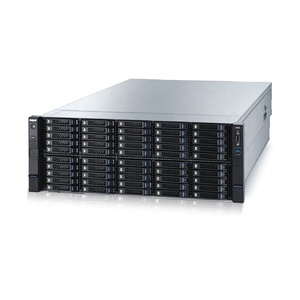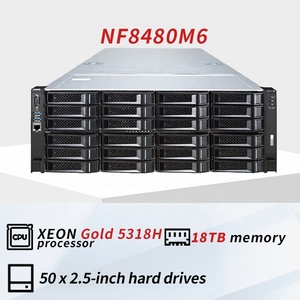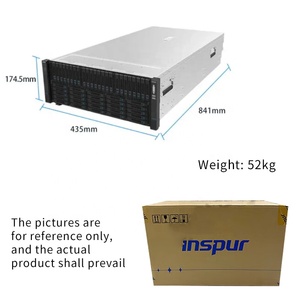
All categories
Featured selections
Trade Assurance
Buyer Central
Help Center
Get the app
Become a supplier

(1998 products available)












































An Inspur server is a brand server that provides computing services to all types of businesses. There are several types of servers, each designed for a specific purpose.
Servers from the Inspur group have intelligent management features that help to improve operational efficiency. They are energy efficient and deliver excellent computing performance, making them suitable for various industry clients.
The use of Inspur servers in application scenarios is crucial and offers various benefits. For example, higher-performance computing-uses scenarios require faster data processing, and faster data processing requires much stronger servers. This calls for the use of the best and most excellent servers, such as Inspur servers, which possess the qualities needed to carry out the tasks required of them. The most commonly used examples of servers are the most powerful servers in the world, which have been used to host sites such as GitHub and Those used for AI and deep learning, such as TensorFlow and Pytorch.
Storage server deployment involves a storage server that has a large memory and extensive hard disk that various Inspur servers possess. Storage servers are used for storage purposes, such as saving and keeping data, including documents, pictures, videos, and other types of content, which can be very useful for companies that are now kept in one place. They can also be used to back up information, which aids in preventing information loss if a device fails or if there is some other type of disaster. It is also very easy to recover data from storage systems thanks to the storage server.
When it comes to virtualization, an Inspur server is an excellent choice because it is able to handle many workloads simultaneously, which has many benefits for businesses and companies. Utilizing virtualization, it is now possible to build and install various virtual servers to create a virtual server farm. Virtual servers function like physical servers, but they run on a physical server as virtual machines. They are able to share the server's resources and are separate from one another, and each virtual server has its own operating system and applications.
In networking and communication, an Inspur server can be used as a proxy server, forwarding client requests to other servers on the internet and providing additional security and privacy.
In application scenarios such as cloud computing, data centers, web hosting, and edge computing, an Inspur server can be used.
When choosing an Inspur server, one must see which applications, workloads, and available budgets are set. Review the hardware specifications, like the server's number of CPUs, memory, storage, and network interface options.
This is essential because it helps determine the server's processing power, memory capacity, storage options, and connectivity features. The number of CPUs and cores per CPU, along with the Intel Xeon or AMD EPYC processor type, directly impact the server's computing capabilities. Basically, it helps choose an Inspur server that can handle the required tasks efficiently.
The memory and storage choices influence how much data the server can hold and the network interface options impact the connectivity opportunities. The Inspur server supports various storage subsystem architectures, including S2G2 and G2C2T2 configurations, enabling flexible and efficient data management solutions tailored to specific requirements. Moreover, the servers offer diverse connectivity options with subsystem services through the Computex/ExpressBox, ExpressCube, and Standard SFF (Small Form Factor) ExpressCube modules, accommodating unique business needs and enhancing operational efficiency.
Different combinations of storage subsystems, such as S2G2 and G2C2T2 architectures, enable efficient data handling and management. Various connection possibilities through ExpressBox, ExpressCube, and Standard SFF Computex/ExpressCube modules enhance flexibility and help businesses run their operations more efficiently. To meet specific needs, trusted collaborators with brands like Intel and Microsoft Azure contribute their expertise to optimizing Inspur servers' performance and dependability. This ensures that different workloads and requirements are properly supported, resulting in smooth computing experiences.
Inspur servers have obtained various certifications, such as Microsoft's Azure Stack HCI certification, declaring compatibility and excellence in specific cloud environments. They also meet standard Huawei certifications, like Huawei FusionStage, demonstrating their ability to work well in multi-cloud platforms with integrated infrastructure. The SAP HANA certification recognizes Inspur's superior performance in handling complex business data tasks. Intel Network Builders and DCB certifications showcase the servers' capabilities in creating outstanding network solutions and unwavering cloud service, affirming their quality and commitment to satisfying different customer needs.
These certifications are evidence of Inspur's dedication to offering reliable servers that operate seamlessly within various IT systems and fulfill different business objectives. Such acknowledgment from distinguished organizations emphasizes the servers' trustworthiness and their ability to meet specific tasks and industry criteria. Inspur servers have earned wide-ranging certification from renowned firms, including Huawei, Microsoft's Azure Stack HCI certification and SAP HANA certification, demonstrating the servers' quality, compatibility, and superior performance in varied IT environments and specific applications.
Q1: What is the purpose of an Inspur server?
A1: The purpose of an Inspur server is to provide computing services and solutions for businesses and organizations. It enables them to handle tasks such as data processing, storage, virtualization, cloud computing, and hosting applications or websites. Inspur servers are designed to deliver high performance, scalability, reliability, and security, meeting the diverse needs of various industries.
Q2: How to set up an Inspur server?
A2: To set up an Inspur server, one needs to unbox the server and install it in a suitable rack. Connect the power cables and network interfaces, then power on the server. Upon startup, access the server BIOS/UEFI for configuration settings like boot sequence, system preferences, and hardware options. Save any changes and boot into the operating system installer. Follow prompts to install the desired OS and configure basic network settings. Finally, install necessary drivers and management software like Inspur’s server manager to monitor and manage the server. Setting up is complete when the server is running the OS and accessible over the network.
Q3: Are Inspur servers good?
A3: Inspur servers are renowned for their reliability, scalability, and performance. They have been deployed in different industries and used by various organizations worldwide. Besides, Inspur servers come with different features, configurations, and customization options to meet specific workloads and requirements. The servers also support open standards and provide flexibility in deployment.
Q4: How to manage an Inspur server?
A4: One can use different methods to manage an Inspur server. They include utilizing the server management software that is typically provided by the server manufacturer. Using the web-based management interface, one can monitor hardware status, manage users, configure networking, and update firmware. Another way to manage the server is by using Remote Desktop Protocol (RDP) or Secure Shell (SSH) to connect to the server. Regularly applying software updates and patches to the operating system, applications, and server firmware is important for optimal performance. Finally, implementing robust backup and disaster recovery strategies will ensure data integrity and business continuity.